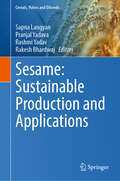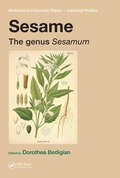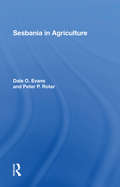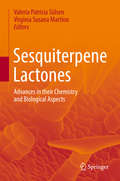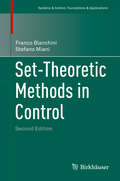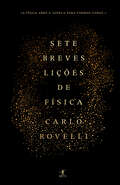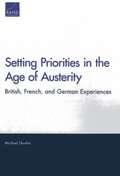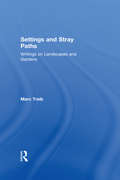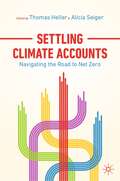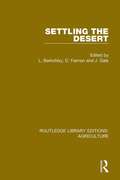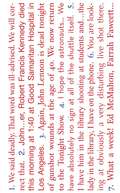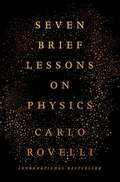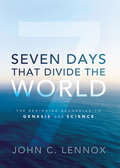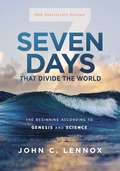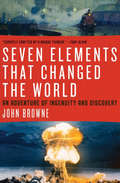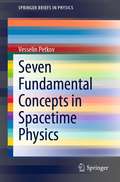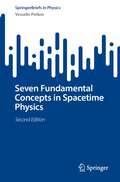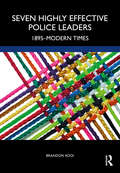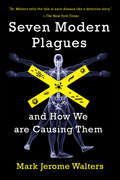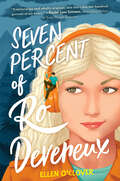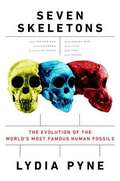- Table View
- List View
Sesame: Sustainable Production and Applications (Cereals, Pulses and Oilseeds)
by Sapna Langyan Pranjal Yadava Rashmi Yadav Rakesh BhardwajThis edited book systematically discusses the advances in biotechnology, agrotechnology, and food technology in shaping sesame production, cultivation and uses to meet the future needs. Sesame (Sesamum indicum) is the oldest oilseed crop known to humans. It has been recognized as one of the most nutritious and health-supportive crops, with several applications in food, cosmetics, and health products. A wide variety of sesame is grown throughout the world, primarily in Asia and Africa. It’s seed and seed oil is being used widely in diverse cuisines. It is also used in cosmetic and health products. Advances in biotechnology, agrotechnology, and food technology in redefining sesame production and uses are of great importance. Various new advanced technologies have been employed to develop high yielding and disease resistant sesame varieties, for better cultivation, seed production, and for utilization of seeds and seed oil in a lot of foods, cosmetic, and health products. This book provides an overview of different advanced technologies, their mechanisms, and their effect on the quality of the sesame crop and sesame seeds/oil. The book also emphasizes the assessment of advanced technology on its limitations and advantages. This book offers the latest research on techniques, applications, and challenges of producing quality sesame crop with recommendations towards sustainable agriculture. The book is a valuable resource for students, researchers and scientists working in the field of sesame production and applications. Industry experts involved in development and management of sustainable production technologies will also find the book beneficial.
Sesame: The genus Sesamum (ISSN)
by Dorothea BedigianThe first comprehensive review of sesame and its close relative, Sesame: the genus Sesamum covers ethnographic data, modern use, linguistic analysis of sesame names from around the world, market size, export and import data, geographical sources, use in the food and cosmetic industries, and much more. The book includes a historical review of the genus Sesamum that reveals its place in present-day traditions and cultivation in Africa and Asia. Expanding coverage from archaeological and anthropological literature from India, Mesopotamia, and Egypt, this ethnobotanical monograph draws on folk sources, reviews the phytochemistry of Sesamum, and presents extensive references.
Sesbania In Agriculture
by Dale O. Evans Peter P RotarSesbania, a member of the legume family, has been the object of study in new efforts to discover, conserve, and use plant genetic resources. This volume brings together the most recent research on the subject and combines it with previous studies and an extensive review of the literature. This work is a synthesis of biological description and applied studies related to the highly variable and versatile Sesbania species. Sesbania occurs in both annual and perennial forms in tropical and subtropical regions and is adaptable to an unusually wide variety of soil conditions, including saline. The most important uses of the plants are in nitrogen fixation (as in green manures) and in cropping systems. Auxiliary uses of the different species are as sources for pulp fibers, fuel wood, animal fodder, and wind-breaks.
Sesquiterpene Lactones: Advances in their Chemistry and Biological Aspects
by Valeria Patricia Sülsen Virginia Susana MartinoThis book addresses chemical and biological aspects related to sesquiterpene lactones (STLs). Experts in different fields have been invited to contribute on this class of compound's chemistry, isolation and identification, biological activities (antibacterial, antifungal, antiviral, antitrypanosomal, antileishmanial,antiplasmodial, antiproliferative and antiinflammatory), synthesis, biosynthesis, derivatization and QSAR analysis. Taxonomic and chemotaxonomic aspects related to the Asteraceae family are also contributed. The book begins by describing the chemical characteristics of STLs, their classification in different skeleton types, synthesis, distribution in nature and their most important biological properties. An overview of the group's main representatives, based on their importance for human health, as well as an update of the most recently isolated STLs, follow. The authors also provide an overview of the most common methods described in the literature for the extraction, purification, identification and structure elucidation of STLs, while also highlighting more recently developed methods. Furthermore, experts in the field provide an in-depth discussion of the most commonly employed in vitro and in vivo antiprotozoal assays against the different stages of parasites, as well as STLs' properties as anticancer agents in numerous cancer cell lines and animal models. Lastly, the book presents examples of the in vitro and in vivo activity of STLs and their mechanism of antiprotozoal action, together with an analysis of ultrastructural alterations, observed using TEM techniques. The book is aimed at scientists working on natural products: both those investigating this particular group of compounds and those who wish to further explore its potential as new drugs for medical conditions such as protozoal diseases and cancer.
Set-Theoretic Methods in Control
by Franco Blanchini Stefano MianiThe second edition of this monograph describes the set-theoretic approach for the control and analysis of dynamic systems, both from a theoretical and practical standpoint. This approach is linked to fundamental control problems, such as Lyapunov stability analysis and stabilization, optimal control, control under constraints, persistent disturbance rejection, and uncertain systems analysis and synthesis. Completely self-contained, this book provides a solid foundation of mathematical techniques and applications, extensive references to the relevant literature, and numerous avenues for further theoretical study. All the material from the first edition has been updated to reflect the most recent developments in the field, and a new chapter on switching systems has been added. Each chapter contains examples, case studies, and exercises to allow for a better understanding of theoretical concepts by practical application. The mathematical language is kept to the minimum level necessary for the adequate formulation and statement of the main concepts, yet allowing for a detailed exposition of the numerical algorithms for the solution of the proposed problems. Set-Theoretic Methods in Control will appeal to both researchers and practitioners in control engineering and applied mathematics. It is also well-suited as a textbook for graduate students in these areas.
Sete breves lições de Física
by Carlo Rovelli«A Física abre a janela para vermos longe.» «Que lugar temos nós, seres humanos que compreendem, decidem, riem e choram, neste grande fresco do mundo que a física contemporânea oferece? Se o mundo é um pulular de efémeros quanta de espaço e de matéria, um imenso jogo de encaixes de espaço e partículas elementares, o que somos nós? Somos também nós feitos apenas de quanta e partículas?» Ao longo de sete breves lições, Carlo Rovelli, físico italiano, guia o leitor, com admirável clareza e surpreendente poesia, numa viagem pela Física moderna, iluminando as suas descobertas mais marcantes e deixando entrever tudo aquilo que a Física ainda desconhece. Através das suas palavras, a Física deixa de ser uma abstracção acessível a poucos para ser parte da vida. Começamos viagem com «a mais bela de todas as teorias», a Teoria da Relatividade de Einstein, que abarca o tempo, o espaço e a compreensão do Universo. Seguimos para a mecânica quântica, outra teoria basilar, que decifra o comportamento da matéria. Passamos por paragens igualmente célebres - a teoria da gravidade, as partículas elementares, os buracos negros - e continuamos viagem para destinos ambiciosos - de que matéria é feito o espaço, qual a natureza do tempo, o que está na origem do cosmos, como funciona a mente humana. O local de chegada é o Homem e o seu lugar no Universo. Estudadas as sete lições, chegamos, inevitavelmente, mais perto daquilo que somos. «Somos feitos da mesma poeira das estrelas de que são feitas as coisas e, tanto quando estamos mergulhados na dor como quando rimos e a alegria resplandece, não fazemos senão ser aquilo que não podemos senão ser: uma parte do nosso mundo.»
Setting Priorities in the Age of Austerity: British, French, and German Experiences
by Michael ShurkinExamines the British, French, and German armies' approaches to accommodating significant budget cuts while attempting to sustain their commitment to full spectrum operations. Specifically, it looks at the choices these armies are making with respect to how they spend dwindling resources: What force structure do they identify as optimal? How much readiness do they regard as necessary? Which capabilities are they abandoning?
Settings and Stray Paths: Writings on Landscapes and Gardens
by Marc TreibThese collected works represent twenty-five years of study of the designed landscape which the author here takes to include gardens, cemeteries, plazas and other shared spaces. Asking essential questions about the nature of order and its perception, this book includes in its impressive scope analyses of both historic and modern works with a geographical distribution that extends across Europe, Asia and North America. With unique depth in many areas of study, Treib brings his expertise to bear on a range of inter-related and mutually influential issues within the subject, taking in an assessment of the lives and contributions of a number of leading figures in the field, the contents of a landscape and the meanings ascribed to it, and a theoretical formulation of the ideas from which or by which landscape architecture is produced.
Settlement, society and cognition in human evolution
by Francis Wenban-Smith Fiona Coward Robert Hosfield Matt PopeThis volume provides a landscape narrative of early hominin evolution, linking conventional material and geographic aspects of the early archaeological record with wider and more elusive social, cognitive and symbolic landscapes. It seeks to move beyond a limiting notion of early hominin culture and behavior as dictated solely by the environment to present the early hominin world as the outcome of a dynamic dialogue between the physical environment and its perception and habitation by active agents. This international group of contributors presents theoretically informed yet empirically based perspectives on hominin and human landscapes.
Settling Climate Accounts: Navigating the Road to Net Zero
by Thomas Heller Alicia SeigerAs drivers of climate action enter the fourth decade of what has become a multi-stage race, Net Zero has emerged as the dominant organizing principle. Hundreds of corporations and investors worldwide, together responsible for assets in the tens of trillions of dollars, are lining-up for the UN Race to Zero. This latest stage in the race to save civilization from heat, drought, fires, and floods, is defined by steering toward zeroing out greenhouse gas emissions by 2050. Settling Climate Accounts probes the practice of Net Zero finance. It elucidates both the state of play and a set of directions that help form judgements about whether Net Zero is going to carry climate action far enough. The book delves into technical analyses and activates the reader’s imagination with narrative accounts of climate action past, present, and future. Settling Climate Accounts is edited and authored by Stanford University faculty and researchers. The first part of the book investigates the rough edges of Net Zero in practice, exploring questions of hedging risk, Scope 3 emissions, greenwashing, and the business of asset management. The second half looks at states, markets, and transitions through the lenses of blended finance, offsets, debt, and securitization. The editors tease out possible solutions and raise further questions about the adequacy and reach of the Net Zero agenda. To effectively navigate the road ahead, the editors call out the need for accountability and ask: who is in charge of making Net Zero add up? Settling Climate Accounts offers context and foundation to ground the rapidly evolving practice of Net Zero finance. Targeted at seasoned practitioners, newly activated leaders, educators, and students of climate action the world over, this book embraces the complexity of climate action and, in so doing, proposes to animate and drive hope.
Settling the Desert (Routledge Library Editions: Agriculture #16)
by L. Berkofsky D. Faiman J. GaleFirst published in 1981. Settling the Desert is an attempt to organise those aspects of scientific and sociological research that are the necessary prerequisites for making the desert a comfortable and profitable place for man to inhabit. In this book, experts from many fields of desert research review the history of desert settlement and agriculture, as well as the present problems encountered by modern desert settlers. Topics discussed include: meteorology, sociology, ecology, water resources, solar energy, innovative desert agriculture, architecture, and animal science.
Seven American Deaths and Disasters
by Kenneth GoldsmithIn Seven American Deaths and Disasters, Kenneth Goldsmith transcribes words used by people describing events they had never prepared themselves to witness, as they unfurl. In doing so, he reveals an extraordinarily rich linguistic panorama of passionate description. Taking its name from the Warhol paintings of the same name, Goldsmith recasts the mundane as the iconic, creating a sense of prose poems that encapsulate both the Kennedy assassinations, that of John Lennon, the Space Shuttle Challenger disaster, 9/11 and the death of Michael Jackson.
Seven Brief Lessons on Physics
by Carlo Rovelli<P>The international bestseller that reveals all the beauty of modern physics in seven short and enlightening lessons. <P> Seven Brief Lessons on Physics is a book about the joy of discovery. <P>Carlo Rovelli brings a playful, entertaining, and mind-bending introduction to modern physics, offering surprising--and surprisingly easy to grasp--explanations of general relativity, quantum mechanics, elementary particles, gravity, black holes, the complex architecture of the universe, and the role humans play in this weird and wonderful world. <P>He takes us to the frontiers of our knowledge: to the most minute reaches of the fabric of space, back to the origins of the cosmos, and into the workings of our minds. <P>"Here, on the edge of what we know, in contact with the ocean of the unknown, shines the mystery and the beauty of the world," Rovelli writes. "And it's breathtaking." <P><b>A New York Times Bestseller</b>
Seven Days That Divide the World: The Beginning According to Genesis and Science
by John C. LennoxWhat did the writer of Genesis mean by “the first day”? Is it a literal week or a series of time periods? If I believe that the earth is 4.5 billion years old, am I denying the authority of Scripture? In response to the continuing controversy over the interpretation of the creation narrative in Genesis, John Lennox proposes a succinct method of reading and interpreting the first chapters of Genesis without discounting either science or Scripture. With examples from history, a brief but thorough exploration of the major interpretations, and a look into the particular significance of the creation of human beings, Lennox suggests that Christians can heed modern scientific knowledge while staying faithful to the biblical narrative. He moves beyond a simple response to the controversy, insisting that Genesis teaches us far more about the God of Jesus Christ and about God’s intention for creation than it does about the age of the earth. With this book, Lennox offers a careful yet accessible introduction to a scientifically-savvy, theologically-astute, and Scripturally faithful interpretation of Genesis.
Seven Days that Divide the World, 10th Anniversary Edition: The Beginning According to Genesis and Science
by John C. LennoxNow revised and updated--John Lennox's acclaimed method of reading and interpreting the first chapters of Genesis without discounting either science or Scripture. What did the writer of Genesis mean by "the first day?" Are the seven days in Genesis 1 a literal week or a series of time periods? If I believe that the earth is 4.5 billion years old as cosmologists believe, am I denying the authority of Scripture?With examples from history, a brief but thorough exploration of the major interpretations, and a look into the particular significance of the creation of human beings, Lennox suggests that Christians can heed modern scientific knowledge while staying faithful to the biblical narrative. He moves beyond a simple response to the controversy, insisting that Genesis teaches us far more about the God of Jesus Christ and about God's intention for creation than it does about the age of the earth.With this book, Lennox offers a careful and accessible introduction to a scientifically-savvy, theologically-astute, and Scripturally faithful interpretation of Genesis.Since its publication in 2011, this book has enabled many readers to see that the major controversy with which it engages can be resolved without compromising commitment to the authority of Scripture. In this newly revised and expanded edition, John clarifies his arguments, responds to comments and critiques of the past decade since its first publication. In particular, he describes some of the history up to modern times of Jewish scholarly interpretation of the Genesis creation narrative as well as spelling out in more detail the breadth of views in the Great Tradition of interpretation due to the early Church Fathers. He shows that, contrary to what many people think, much of the difficulty with understanding the biblical texts does not arise from modern science but from attempting to elucidate the texts in their own right.
Seven Doors to Death (Escape from Planet Alcatraz)
by Michael DahlAs Zak Nine and his friend Erro make their way around a strange lake, they discover an ancient golden building. The boys decide to go inside to take a closer look, but unwittingly stumble into the legendary Octagon: an underground chamber with eight mysterious doors. One door will lead the boys to freedom, but the rest lead to sinister traps and certain death! Will Zak and Erro outwit the deadly room and escape before it's too late?
Seven Elements That Have Changed the World: An Adventure of Ingenuity and Discovery
by John BrowneWith carbon we access heat, light and mobility at the flick of a switch, while silicon enables us to communicate across the globe in an instant.Yet our use of the Earth's mineral resources is not always for the benefit of humankind--our relationship with the elements is one of great ambivalence. Uranium is both productive (nuclear power) and destructive (nuclear bombs); iron is the bloody weapon of war, but also the economic tool of peace; our desire for alluring gold is the foundation of global trade, but has also led to the death of millions. John Browne, CEO of BP for twelve years, vividly describes how seven elements are shaping the world around us, for better and for worse.Combining history, science and politics, Seven Elements takes you on a present-day adventure of human passion, ingenuity and discovery. This journey is far from over: We continue to find surprising new uses for these seven elements. Discover how titanium pervades modern consumer society, how natural gas is transforming the global energy sector, and how an innovative new form of carbon could be starting a technology revolution.
Seven Fundamental Concepts in Spacetime Physics (SpringerBriefs in Physics)
by Vesselin PetkovThe book presents seven fundamental concepts in spacetime physics mostly by following Hermann Minkowski’s revolutionary ideas summarized in his 1908 lecture "Space and Time." These concepts are: spacetime, inertial and accelerated motion in spacetime physics, the origin and nature of inertia in spacetime physics, relativistic mass, gravitation, gravitational waves, and black holes. They have been selected because they appear to be causing most misconceptions and confusion in spacetime physics.
Seven Fundamental Concepts in Spacetime Physics (SpringerBriefs in Physics)
by Vesselin PetkovThe book presents seven fundamental concepts in spacetime physics mostly by following Hermann Minkowski’s revolutionary ideas summarized in his 1908 lecture "Space and Time." These concepts are: spacetime, inertial and accelerated motion in spacetime physics, the origin and nature of inertia in spacetime physics, relativistic mass, gravitation, gravitational waves, and black holes. They have been selected because they appear to be causing most misconceptions and confusion in spacetime physics. This second edition has been revised to include additional clarifications, more detailed elaboration of the arguments and also new material published in the interim.
Seven Highly Effective Police Leaders: 1895-Modern Times
by Brandon KooiThis book provides a valuable addition to the policing literature by detailing the backgrounds and histories of seven important police leaders: Teddy Roosevelt, August Vollmer, O.W. Wilson, Penny Harrington, Bill Bratton, Chuck Ramsey, and Chris Magnus. Seven Highly Effective Police Leaders teaches important history, highlighting the impact on the evolution of American policing by academia and social science. Each historical biography demonstrates the importance of each leader’s decision-making and how it continues to shape the future of U.S. law enforcement. Readers are informed about each police leader's background and how their leadership was shaped by the political and historical environments in which they led. The book is useful for educational courses in policing, American history, leadership, and strategic planning. Additionally, the general public will find this book insightful regarding contemporary mass social justice protests linked to the unique history of the United States.
Seven Ideas that Shook the Universe, Third Edition
by Nathan Spielberg Bryon D. AndersonSeven Ideas That Shook the Universe explores the history of seven important themes in physics: Copernican astronomy, Newtonian mechanics, energy and entropy, relativity, quantum theory, and conservation principles and symmetries.
Seven Modern Plagues: and How We Are Causing Them
by Mark Jerome WaltersEpidemiologists are braced for the big one: the strain of flu that rivals the pandemic of 1918-1919, which killed at least 20 million people worldwide. In recent years, we have experienced scares with a host of new influenza viruses: bird flu, swine flu, Spanish flu, Hong Kong flu, H5N1, and most recently, H5N7. While these diseases appear to emerge from thin air, in fact, human activity is driving them. And the problem is not just flu, but a series of rapidly evolving and dangerous modern plagues. According to veterinarian and journalist Mark Walters, we are contributing to-if not overtly causing-some of the scariest epidemics of our time. Through human stories and cutting-edge science, Walters explores the origins of seven diseases: mad cow disease, HIV/AIDS, Salmonella DT104, Lyme disease, hantavirus, West Nile, and new strains of flu. He shows that they originate from manipulation of the environment, from emitting carbon and clear-cutting forests to feeding naturally herbivorous cows "recycled animal protein." Since Walters first drew attention to these "ecodemics" in 2003 with the publication of Six Modern Plagues, much has been learned about how they developed. In this new, fully updated edition, the author presents research that precisely pinpoints the origins of HIV, confirms the link between forest fragmentation and increased risk of Lyme disease, and expands knowledge of the ecology of West Nile virus. He also explores developments in emerging diseases, including a new chapter on flu, examining the first influenza pandemic since the Hong Kong flu of 1968; a new tick-borne infection in the Mid-West; a second novel bird flu in China; and yet a new SARS-like virus in the Middle East. Readers will not only learn how these diseases emerged but the conditions that make future pandemics more likely. This knowledge is critical in order to prevent the next modern plague.
Seven Percent of Ro Devereux
by Ellen O'CloverFans of Emma Lord, Rachel Lynn Solomon, and Alex Light will love this clever, charming, and poignant debut novel with a masterful slow-burn romance at its core about a girl who must decide whether to pursue her dreams or preserve her relationships, including a budding romance with her ex-best friend, when an app she created goes viral. <P><P> Ro Devereux can predict your future. Or, at least, the app she built for her senior project can. <P><P> Working with her neighbor, a retired behavioral scientist, Ro created an app called MASH, designed around the classic game Mansion Apartment Shack House, that can predict a person’s future with 93% accuracy. The app will even match users with their soulmates. Though it was only supposed to be a class project, MASH quickly takes off and gains the attention of tech investors. <P><P> Ro’s dream is to work in Silicon Valley, and she’ll do anything to prove to her new backing company—and the world—that the app works. So it’s a huge shock when the app says her soulmate is Miller, her childhood best friend with whom she had a friendship-destroying fight three years ago. <P><P> Now thrust into a fake dating scenario, Ro and Miller must address the years of pain between them if either of them will have any chance of achieving their dreams. And as the app takes on a life of its own, Ro sees that it’s affecting people in ways she never expected—and if she can’t regain control, it might take her and everything she believes in down with it.
Seven Skeletons: The Evolution of the World's Most Famous Human Fossils
by Lydia PyneAn irresistible journey of discovery, science, history, and myth making, told through the lives and afterlives of seven famous human ancestorsOver the last century, the search for human ancestors has spanned four continents and resulted in the discovery of hundreds of fossils. While most of these discoveries live quietly in museum collections, there are a few that have become world-renowned celebrity personas--ambassadors of science that speak to public audiences. In Seven Skeletons, historian of science Lydia Pyne explores how seven such famous fossils of our ancestors have the social cachet they enjoy today.Drawing from archives, museums, and interviews, Pyne builds a cultural history for each celebrity fossil--from its discovery to its afterlife in museum exhibits to its legacy in popular culture. These seven include the three-foot tall "hobbit" from Flores, the Neanderthal of La Chapelle, the Taung Child, the Piltdown Man hoax, Peking Man, Australopithecus sediba, and Lucy--each embraced and celebrated by generations, and vivid examples of how discoveries of how our ancestors have been received, remembered, and immortalized. With wit and insight, Pyne brings to life each fossil, and how it is described, put on display, and shared among scientific communities and the broader public. This fascinating, endlessly entertaining book puts the impact of paleoanthropology into new context, a reminder of how our past as a species continues to affect, in astounding ways, our present culture and imagination.From the Hardcover edition.
Seven Small Inventions that Changed the World
by Roma AgrawalTechnology and engineering surround us. From HUGE things, like spaceships and skyscrapers, to much smaller things like the toaster in our kitchen and the shoes on our feet. But all of these things only exist because of seven small inventions: the nail, the wheel, the spring, the magnet, the lens, the pump and ... string. And each of these inventions has a fascinating story to tell.Travel through centuries of history, through ancient Egypt, along the Silk Road, across the high seas and even into space, and discover how each of these seven small inventions came to be, how they work and how they changed the world forever. Find out how it's thanks to the potter's wheel that the International Space Station exists, and how the same nails that built pirate ships hold together the tallest buildings in the world. In this children's illustrated adaptation of her adult book, Nuts and Bolts, award-winning engineer turned bestselling author Roma Agrawal makes STEM accessible, intriguing and aspirational, and encourages children to be endlessly curious about the 'things' that make up our world.
